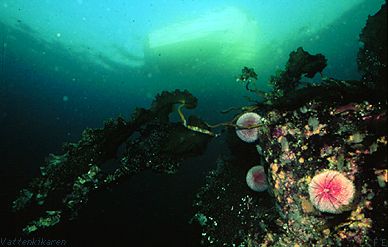 |
|
Predation and grazing
Predation is when one animal eats another, while
grazing is when an animal eats algae or some other form of primary producer.
Predators can have a great effect on the appearance of cliffs and rock surfaces.
Shelfish, crabs, starfish, sea-urchins, fish and birds are examples of important
predators and grazers along rocky shorelines. For many small
animals, predation and grazing can be of importance, aswell as parasites
and sickness producing micro- organisms.
| This kelp forest
is very sparse. This can be the result of sea-urchins over-grazing
on the kelp. |
It is not only the size of the population that
predators and grazers effect, but also the size of the individuals, for
example, larger individuals have better protection, can defend themselves
effectively, so that predators do not effect them. On the other hand, small
individuals can be more common within certain areas, for example because
larger predators are unable to reach them in crevices.
 |
Page 43 of
52 |
 |
|



